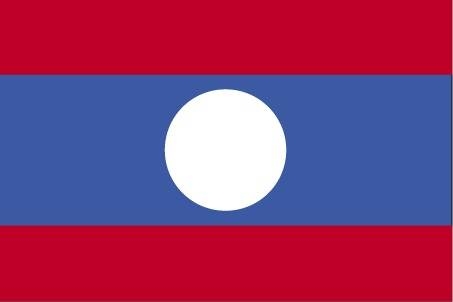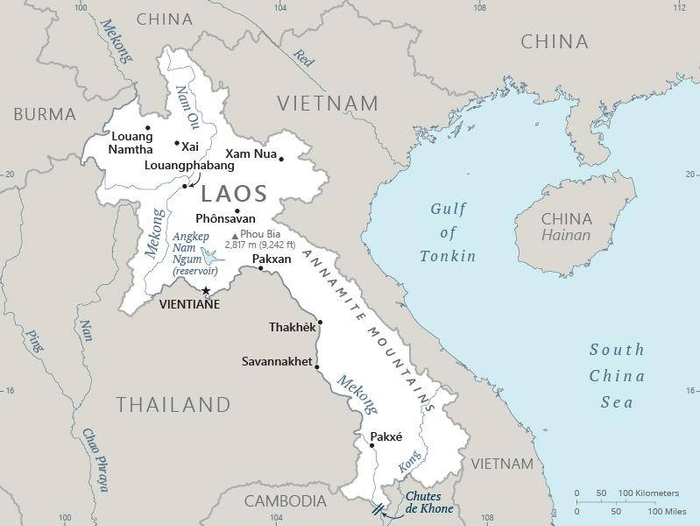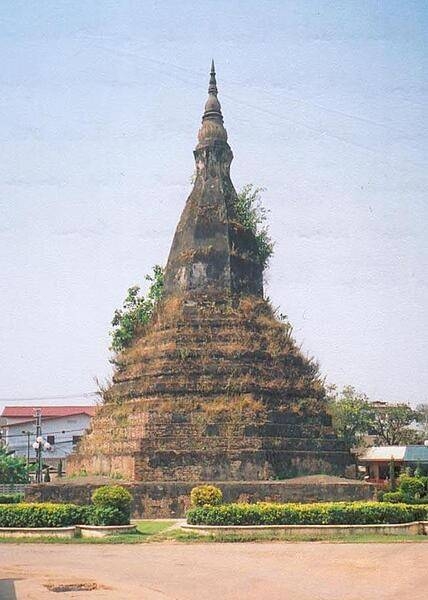150 Laos

Three horizontal bands of red (top), blue (double width), and red with a large white disk centered in the blue band. The red bands recall the blood shed for liberation. The blue band represents the Mekong River and prosperity. The white disk symbolizes the full moon against the Mekong River, but also signifies the unity of the people under the Lao People’s Revolutionary Party, as well as the country’s bright future.
Flag courtesy of the CIA World Factbook

Map courtesy of the CIA World Factbook

A stupa is a mound-like structure containing Buddhist relics. Located around the corner from the US Embassy in Vientiane, That Dam (“the black stupa”) is one of the oldest Buddhist monuments in Vientiane. Legend holds that a seven-headed dragon lives underneath the stupa and protects the city.
Photo courtesy of the CIA World Factbook
Government
According to Britannica, since its establishment in December 1975, the Lao People’s Democratic Republic (LPDR) has been effectively controlled by the communist Lao People’s Revolutionary Party (LPRP). This party, in alliance with the Vietnamese communists, carried out the revolution that ended in its seizure of power and the abolition of the monarchy. Top government positions—beginning with the president, who is head of state, and the prime minister, who is the head of government—are selected from high-ranking party members who constitute a Central Committee with the Politburo at the head.
The constitution of 1991, which declares the party to be the “leading nucleus” of the political system, provides for a National Assembly, the members of which are elected to five-year terms. The National Assembly elects the president and vice president and approves presidential appointments of the prime minister and members of the cabinet (Council of Ministers). The president and ministers serve five-year terms.
The country is divided into some 16 provinces, as well as the Vientiane municipality and the Xaisomboun special zone; the provinces are subdivided further into districts and villages. Governors of provinces and the mayor of Vientiane are appointed by the president, and lower-level local administrators, including deputy provincial governors, deputy mayors, and district chiefs, are named by the prime minister. Villages are led by village heads. At each level of local government, there are party committees and administrative committees, often headed by the same individuals. Local administrations have considerable autonomy in economic matters.
The judicial system is headed by the People’s Supreme Court, the president of which is elected by the National Assembly on recommendation of its own Standing Committee. Below the People’s Supreme Court are provincial, municipal, district, and military courts. Judges for these courts are also appointed by the Standing Committee of the National Assembly.
Department of Civil Aviation (DCAL)
The Department of Civil Aviation, Lao PDR (DCAL) is the regulatory body for aviation safety matters in the Lao People’s Democratic Republic. Inspectors from Flight Safety Division (Airworthiness, Flight Operation, Flight Standard, Personnel Licensing Section), Air Navigation Division, Aeronautical Telecommunication Division, Aerodrome Division and Aviation Security Division are appointed by the Director General Civil Aviation (DGCA) and are responsible for the Safety Oversight on all aviation safety matters.
DCAL is one of 11 departments under the peruse of Ministry of Public Works & Transport (MPWT) established under the Ministerial Decision №. 15702/MPWT dated 1st September 2014. It has the overall policy responsibility to assist MPWT concerning all general administration matters on civil aviation affairs within Lao PDR’s Flight Information Region (LAO FIR)
The Minister has authorized the Director General of Civil Aviation (DGCA) as the appropriate authority and executive agent on all Aviation Security matters in Lao PDR and to exercise or perform on his behalf any of his powers or duties. DGCA has the power to issue directives or instructions, such as Airworthiness Notices and Flight Operations Notices, as necessary for the regulation and safe management of civil aviation.
Airspace
SkyVector – Google Maps – ADS-B Exchange
ICAO countries publish an Aeronautical Information Publication (AIP). This document is divided into three parts: General (GEN), En Route (ENR) and Aerodromes (AD). ENR 1.4 details the types of airspace classes they chose to adopt from classes A through G.
Laos AIP– maps
Drone Regulations
Lao Civil Aviation Regulation Part 17: Unmanned Aircraft
Advanced Air Mobility (AAM) Regulations & Policies
None found by the author.
However, should you, the reader, happen to stumble across something to the contrary, please email the author at FISHE5CA@erau.edu and you may be mentioned in the ACKNOWLEDGEMENTS section of this book by way of thanks for contributing to this free eBook!
Advanced Air Mobility (AAM) News
None found by the author.
However, should you, the reader, happen to stumble across something to the contrary, please email the author at FISHE5CA@erau.edu and you may be mentioned in the ACKNOWLEDGEMENTS section of this book by way of thanks for contributing to this free eBook!
Short Essay Questions
Scenario-Based Question
You have been hired by a Drone Startup Company. Your boss has immediately assigned this job to you.
They need you to prepare a one-page memo detailing the legalities of using a drone to film the stupa, pictured above.
They need you to mention any national laws and local ordinances.
They specifically want to know what airspace (insert pictures) you will be operating in and whether or not you need an airspace authorization.
Does it matter whether or not you are a citizen of the country?
Lastly, there is a bonus for you if, as you scroll through this chapter, you find any typos or broken links!
Short Essay Questions
- What are the drone categories?
- How is registration addressed?
- How is remote ID addressed?
- What are the model aircraft rules?
- What are the commercial drone rules?
- Are there waivers or exemptions to the rules? If so, for what?
- Would you share a link to an interactive airspace map?
- How is BVLOS addressed?
- How can you fly drones at night?
- How can you fly drones over people?
- Where do you find drone NOTAMs?
- What are the rules for drone maintenance?
- What are the rules for an SMS program?
- What are some unique rules not mentioned above?
- What are the C-UAS rules?
- What are the AAM rules?

